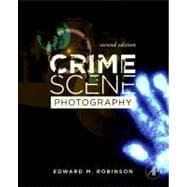
Note: Supplemental materials are not guaranteed with Rental or Used book purchases.
Purchase Benefits
What is included with this book?
| Foreword to the Second Edition | p. xi |
| Foreword to the First Edition | p. xiii |
| Acknowledgments | p. xv |
| Introduction | p. xvii |
| History of Forensic Imaging | p. 1 |
| My Inspiration | p. 1 |
| The Practical Value | p. 2 |
| The History | p. 3 |
| Summary | p. 17 |
| Composition and Cardinal Rules | p. 19 |
| Use-Once (or, Use One Time) Camera versus a Professional Camera System | p. 20 |
| Composition and Cardinal Rules | p. 22 |
| Cardinal Rules of Crime Scene Photography | p. 46 |
| Summary | p. 47 |
| Basic Exposure (Non-Flash) Concepts | p. 51 |
| The Proper Exposure Triangle | p. 52 |
| Shutter Speed as Motion Control | p. 76 |
| Using Slow Shutter Speeds to Eliminate Rain and Snow | p. 79 |
| Reciprocal Exposures | p. 82 |
| The Reflective Light Meter | p. 86 |
| "Normal" and "Non-Normal" Scenes | p. 90 |
| Tools for Determining "Proper" Exposures with Tricky Scenes | p. 98 |
| Bracketing | p. 103 |
| The F/16 Sunny Day Rule | p. 107 |
| Causes for Complete Rolls of Film with Exposure Errors | p. 111 |
| Common Filters | p. 112 |
| The Eye Cup Cover | p. 119 |
| Summary | p. 121 |
| Focus, Depth of Field, and Lenses | p. 125 |
| Focus | p. 126 |
| Depth of Field | p. 156 |
| Lenses | p. 166 |
| Summary | p. 206 |
| Electronic Flash | p. 209 |
| Guide Numbers | p. 210 |
| Flash Sync Speeds | p. 213 |
| Set the Flash for the Film Used (If Still Using a Film Camera) | p. 217 |
| Manual Flash Mode | p. 217 |
| The Inverse Square Law | p. 237 |
| Automatic and Dedicated Flash Exposure Modes | p. 242 |
| Built-in Flash Units | p. 250 |
| Fill-in Flash | p. 251 |
| Oblique Light, Both Flash and Non-Flash (Flashlight) | p. 258 |
| Bounce Flash | p. 279 |
| Painting with Light | p. 286 |
| Summary | p. 300 |
| Crime Scene Photography | p. 305 |
| Photo Documentation Forms | p. 306 |
| Overall Photographs | p. 313 |
| Midrange Photographs | p. 329 |
| Close-Up Photographs | p. 336 |
| The Photographic Documentation of Bodies and Wounds | p. 341 |
| Summary | p. 363 |
| Ultraviolet, Infrared, and Fluorescence | p. 367 |
| The Electromagnetic Spectrum (EMS) | p. 363 |
| Ultraviolet Light (UV) | p. 373 |
| Infrared Light (IR) on the Electromagnetic Spectrum | p. 380 |
| Visible Light Fluorescence | p. 387 |
| Summary | p. 394 |
| Photogrammetry | p. 399 |
| Introduction to Photogrammetry | p. 400 |
| Perspective Grid Photogrammetry | p. 402 |
| Perspective Disc Photogrammetry | p. 417 |
| Natural Grid Photogrammetry | p. 422 |
| Reverse Projection Photogrammetry | p. 428 |
| Rhino Photogrammetry | p. 432 |
| Summary | p. 436 |
| Special Photography Situations | p. 441 |
| Accident Photography | p. 442 |
| Surveillance Photography | p. 459 |
| Aerial Photography | p. 468 |
| Underwater Photography | p. 474 |
| Summary | p. 484 |
| Digital Imaging Technologies | p. 489 |
| In the Beginning | p. 490 |
| Expose Yourself to Digital Imaging Concepts: Bits, Bytes, Pixels, and Dots | p. 500 |
| Take a Picture! It Lasts Longer à Or Does It? | p. 511 |
| Image S&M à Storage and Management of Your Digital Images | p. 518 |
| Summary | p. 530 |
| Digital Image Processing of Evidentiary Photography | p. 533 |
| Best Practices and Guidelines | p. 537 |
| General Guidelines and Requirements | p. 537 |
| The Order of Enhancements | p. 540 |
| Getting Started | p. 541 |
| The Imaging Process (The Act Formerly Known as "Enhancement") | p. 549 |
| Summary | p. 580 |
| Legal Issues Related to Photographs and Digital Images | p. 583 |
| Criteria of Photographs and Digital Images as Evidence | p. 584 |
| The Purpose of Crime Scene Photographs | p. 594 |
| Photographs of Suspects and Evidence | p. 594 |
| Legal Implications of Digital Imaging | p. 596 |
| International Association for Identification (IAI) Resolution 97-9 | p. 604 |
| Case Law Citations Relevant to Film and Digital Images | p. 605 |
| Canadian Cases | p. 642 |
| Summary | p. 648 |
| Appendix | p. 651 |
| Glossary | p. 667 |
| Subject Index | p. 685 |
| Table of Contents provided by Ingram. All Rights Reserved. |
The New copy of this book will include any supplemental materials advertised. Please check the title of the book to determine if it should include any access cards, study guides, lab manuals, CDs, etc.
The Used, Rental and eBook copies of this book are not guaranteed to include any supplemental materials. Typically, only the book itself is included. This is true even if the title states it includes any access cards, study guides, lab manuals, CDs, etc.